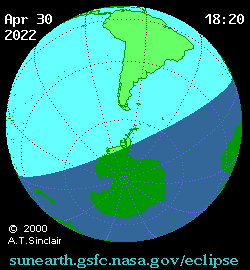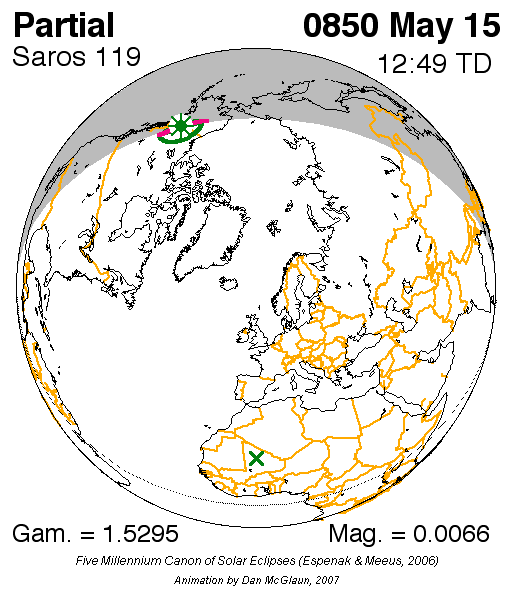A remote solar eclipse this coming weekend sets us up for the first total lunar eclipse of 2022.
The first eclipse season for 2022 is nigh. About twice a year, the two nodes where the Moon’s orbit intersects the ecliptic align and an eclipse season occurs, book-ended by one each solar and lunar eclipses spaced about two weeks apart.

The eclipse – This weekend’s brief remote partial solar eclipse ushers in the beginning of the first such season for 2022. The event is a remote one, spanning the southern Pacific Ocean, Easter Island, coastal Antarctica and the southern tip of South America. At its maximum, expect the Sun to be 64% obscured by the Moon over the stretch of ocean between Tierra del Fuego and Antarctica.

Timing for key moments during the eclipse are in Universal Time (UT):
P1: Start of the partial phases of the eclipse (over the South Pacific): 18:45 UT.
Mid-eclipse: 20:41 UT.
P4: The end of partial phases for the eclipse (near the northern Pacific coast of Chile): 22:38 UT.
Though most of humanity will sit this eclipse out, the region along the coast of Chile and the Andes—to include the Paranal Observatory complex—should see a dramatic ‘horned sunset eclipse.’ sinking into the Pacific.

Eclipse Safety
Of course, safe solar observing precautions must be practiced during all stages of Saturday’s eclipse. This means using eclipse glasses or filters made for solar observing that fit snugly over the aperture (front) of optics.
Keep an eye out for strange effects during the partial solar eclipse, such as gaps in the tree leaves acting as tiny mini-pinhole projectors, covering the ground with crescent suns.
Sunspot prospects – The Sun has been extremely active as of late, as we head towards the peak for solar sunspot cycle No. 25. As of writing this, there are no less than eight active sunspot regions turned Earthward, making for a photogenic Sun, near mid-partial solar eclipse.

Tales of the Saros
This particular eclipse is member 66 of the 71 eclipses in solar saros cycle series 119. This saros is an old one stretching all the way back to May 15th 850 AD. The series produced its last annular solar eclipse on May 18, 1950 and is now on the way out, ending with its final shallow partial solar eclipse next century on June 24, (cue Rush) 2112.

Follow that Moon
The next few mornings sees the slim waning crescent Moon slide by a conga line of planets at dawn, as a prelude to the eclipse. The current lineup includes (in order from the Sun) Jupiter, Venus, Mars and Saturn… Jupiter and Venus will have an especially close 12’ encounter visible worldwide on the morning of the eclipse, April 30th. The planets continue to shuffle at dawn through May and are joined by Mercury in early June, when you can actually see all of the naked eye planets in order (!) at dawn.

The first spotting the Moon on the nights following the eclipse also mark the end of the Muslim month of Ramadan, and the start of the three day celebration of Eid al-Fitr.
But there’s more to come. May 16th sees the first of two total lunar eclipses for 2022, with both favoring the Americas… and hey, we’re just inside two years ‘til the next total solar eclipse across the United States on April 8th, 2024.
More to come!
Lead image credit: A dazzling partial solar eclipse. Credit: Dave Dickinson
The post A Partial Solar Eclipse Kicks Off the First Eclipse Season of 2022 appeared first on Universe Today.
No comments:
Post a Comment